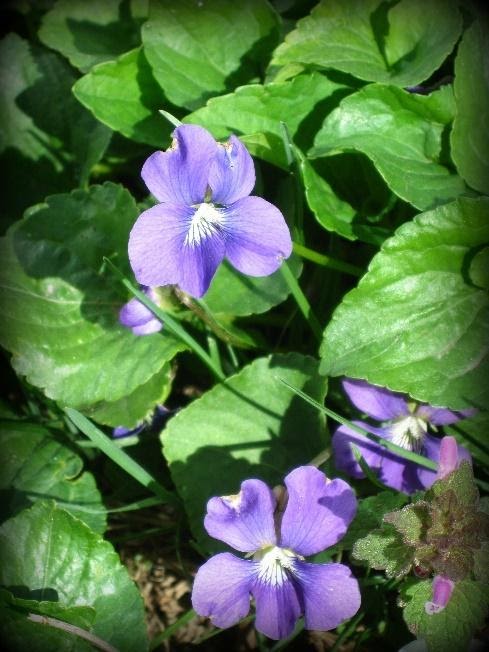Name: Violets
Botanical Name: Viola spp.
Form: wildflower
Parts Used: seeds, greens and flowers
Citation: Guenther, K. (2020, January 12) Violets as wildlife food [Web log post.] Retrieved: supply the date, from http://wildfoods4wildlife.com
Getting Started
Violets are common to many yards and are a good beginner-forager plant due to their easy-to-identify nature and their tendency to naturalize and regenerate. A number of birds and mammals eat the seeds, but I have no idea how one would harvest seed in enough quantity to bother. Mice will eat the corms and roots, but it’s hard to imagine a rehabber working to get violet roots just for mice. Which leaves only one major reason to harvest violet greens: for the cottontails.
Violaceae (Violet family)
Viola (Violet genus)
I love violets for their durability and friendliness and their ability to generate and regenerate on the landscape with ease. But, they are a trickster plant when it comes to exact identification, as different species look a lot like each other to begin with, plus they have the audacity to hybridize. Wow, are there a lot of different violets out there.
| Common name | Virginia Viola Species | Origin | Rare Plant Status |
| LeConte’s violet | V. affinis | non-native | Yes, in some states (not Virginia) |
| european field pansy | V. arvensis | native | Not rare |
| field pansy | V. bicolor | native | Not rare |
| sweet white violet | V. blanda | native | Not rare |
| coast violet | V. brittoniana | native | Globally appears secure, vulnerable in Virginia |
| canada violet | V. canadensis | native | Yes, in some states (not Virginia) |
| marsh blue violet | V. cucullata | native | Not rare |
| salad violet | V. esculenta | native | Globally appears secure, vulnerable in Virginia |
| northern downy violet | V. fimbriatula | native | Not rare |
| halberd-leaved yellow violet | V. hastate | native | Not rare |
| southern wood violet | V. hirsutila | native | Yes, in some states (not Virginia) |
| large-leaved white violet | V. incognita | native | Globally appears secure, may be at risk in Virginia |
| dog-violet | V. labradorica | native | Yes, in some states (not Virginia) |
| lance-leaved violet | V. lanceolata | native | Yes, in some states (not Virginia) |
| smooth white violet | V. macloskeyi | native | Globally secure, vulnerable in Virginia |
| sweet violet | V. odorata | non-native | Not rare |
| cleft violet | V. palmata var. diltata | native | Yes, in some states (not Virginia) |
| wood violet | V. palmata var. palmate | native | Yes, in some states (not Virginia) |
| bird’s-foot violet | V. pedata | native | Yes, in some states (not Virginia) |
| prairie violet | V. pedatifolia | native | Globally secure, critically imperiled in Virginia |
| primrose-leaved violet | V. primulifolia | native | Yes, in some states (not Virginia) |
| yellow violet | V. pubescens | native | Yes, in some states (not Virginia) |
| long-spurred violet | V. rostrata | native | Not rare |
| round-leaved violet | V. rotundifolia | native | Yes, in some states (not Virginia) |
| arrow-leaved violet | V. sagittata | native | Not rare |
| northern blue violet | V. septentrionalis | native | Globally secure, vulnerable in Virginia |
| common blue violet | V. sororia | native | Not rare |
| striped violet | V. striata | native | Yes, in some states (not Virginia) |
| lobed violet | V. subsinuata | native | Not rare |
| pansy | V. tricolor | non-native | Not rare |
| three-parted violet | V. tripartite | native | Globally secure, critically imperiled in Virginia |
| prostrate blue violet | V. walteri | native | Globally appears secure, imperiled in Virginia |
Virginia Botanical Associates. (Accessed November 2015). Digital Atlas of the Virginia Flora (http://www.vaplantatlas.org). c/o Virginia Botanical Associates, Blacksburg.
USDA, NRCS. 2015. The PLANTS Database (http://plants.usda.gov, 24 November 2015). National Plant Data Team, Greensboro, NC 27401-4901 USA.
Key Features to Look For
In addition to the identification guide of your choice, here are a couple of features you should see on this plant:
- Ankle-high plants that often spread over time
- Flowers are irregular with 2 petals up and 3 petals down
- Often heart-shaped leaves that curl up slightly at the sides forming a keel shape on the underside of the leaf.
- Flower colors are usually either whites, blues, purples or yellows, or some combination
- Flowers have a “spur” on the backside of the flower, a pointy part where the petals join
- Often just one flower petal has veins
- Often the stem of the flower has no leaves; leaves are on their own individual stems.
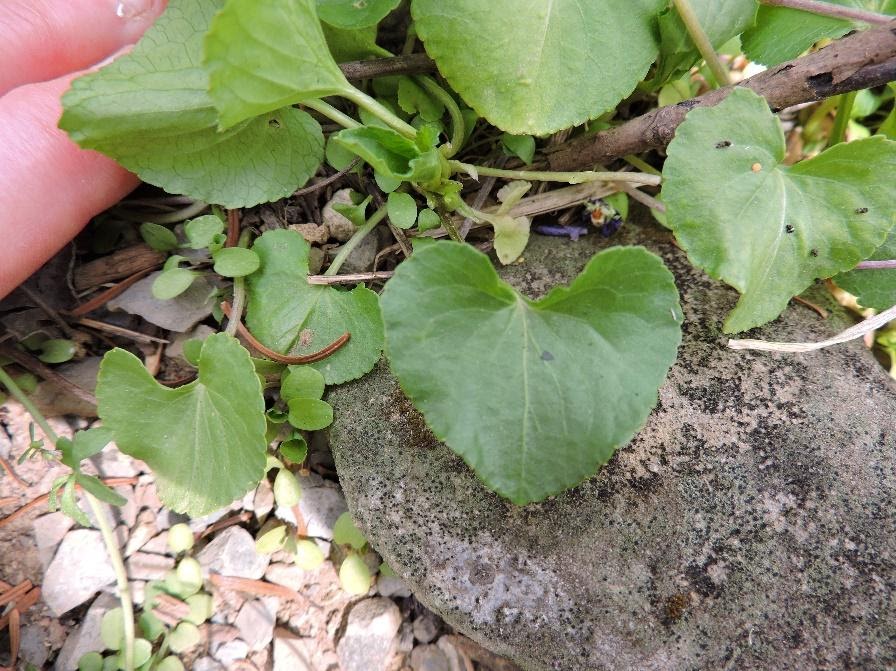
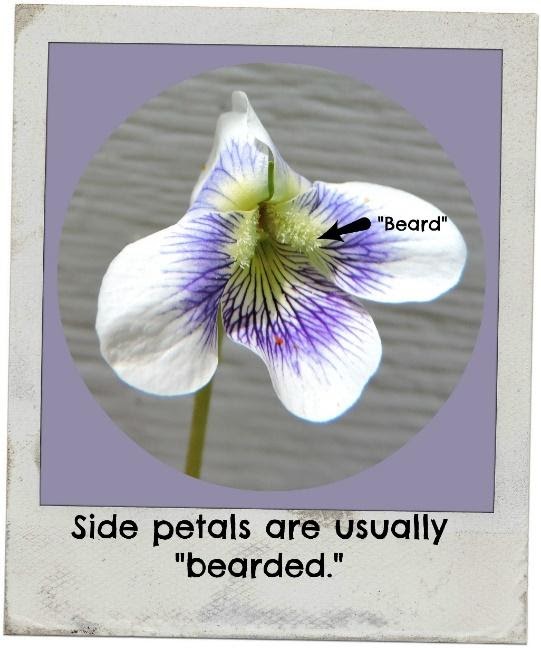
About this Species
The selected violet for this article is likely a violet hybrid (V. sororia is my best guess.) Since violets often hybridize, identification can be difficult to achieve. If you want to try to identify a violet down to the species level, the following are the items that will help you key it out using a taxonomic key:
- whether the flower stands up above the leaves
- whether and how many of the interior flower petals have “beards”
- how many and to what extent the petals have veins
- whether the leaves have hairs or are smooth
Violets are high in Vitamins A and C. They are mildly laxative, yellow violets more so. Violets are also said to help detoxify the blood acting as alteratives that can be used long-term (Elpel 2013).
Flower Description: Violet flowers are slightly irregular with 2 petals up and 3 petals down and 5 separate sepals. The lowest petal is usually more heavily streaked with veins of a different color and the lower petal is slightly larger than the others. The flowers are similar to pansies, which are also in this family. Violet flowers are usually variations of whites, purples, blues and yellows.
[/one_half]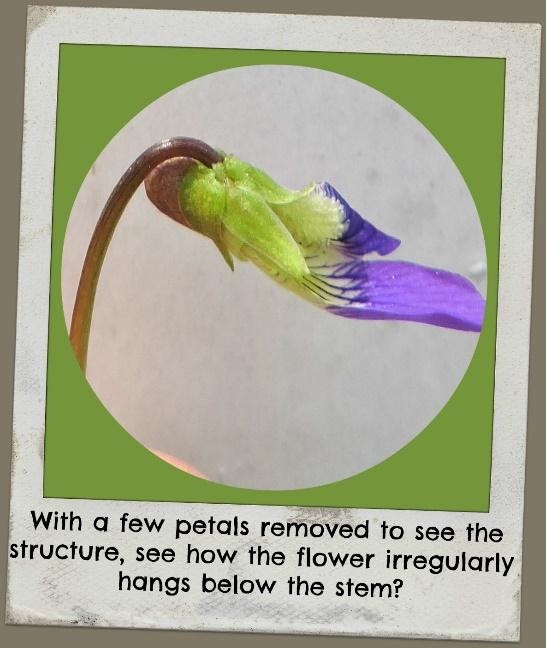
Leaf Description: Many violet leaves are simple, un-lobed, toothed, heart-shaped and curl up slightly at the sides forming a keel shape on the underside of the leaf. They have long stems (petioles) which either emerge at ground level (basal) or alternate up the stem. There is a lot of variation in leaves for violets. Flowers are more uniform across species.
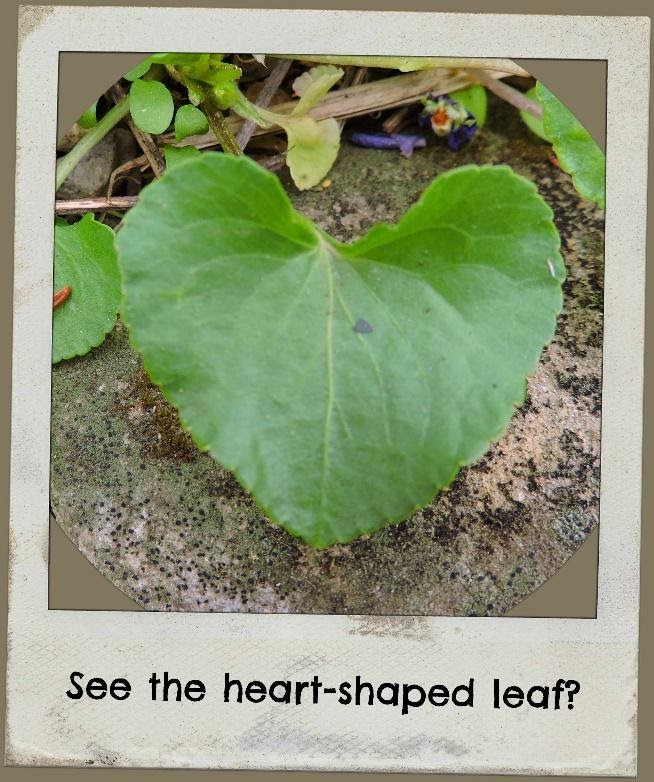
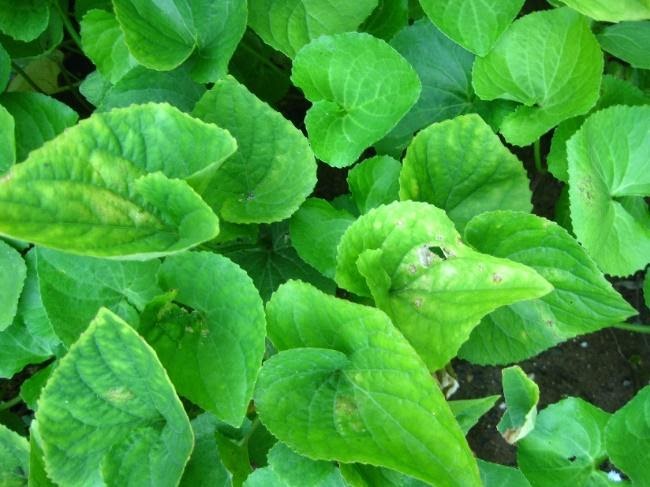
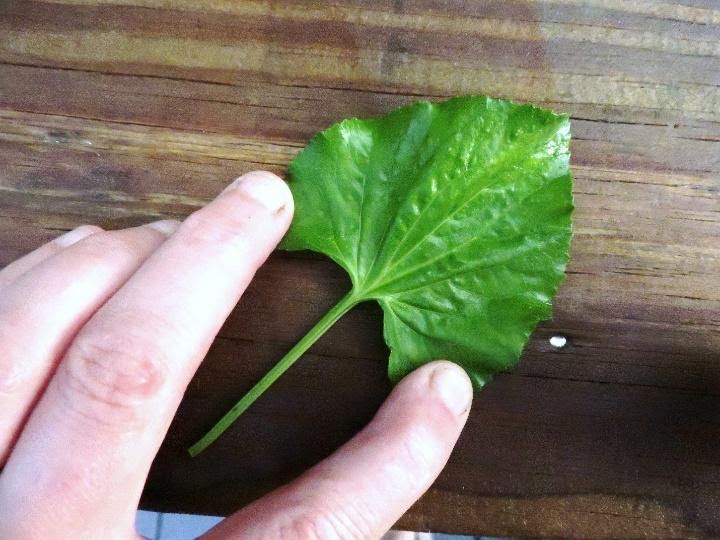
Seed/ Fruit Size: The seed capsule is striking if you see one. It is a small, three-arm-shaped packet with the seeds lined up inside like peas in a pod that pops open to disperse the seeds.

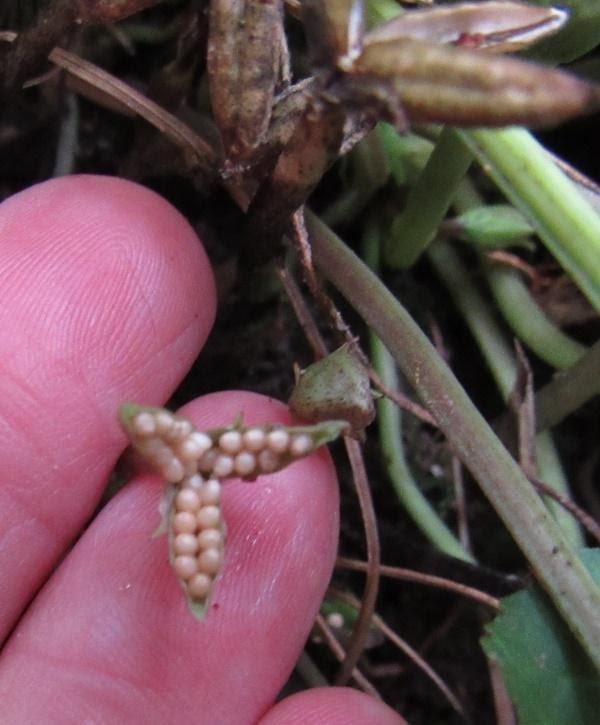
Roots and Corms:
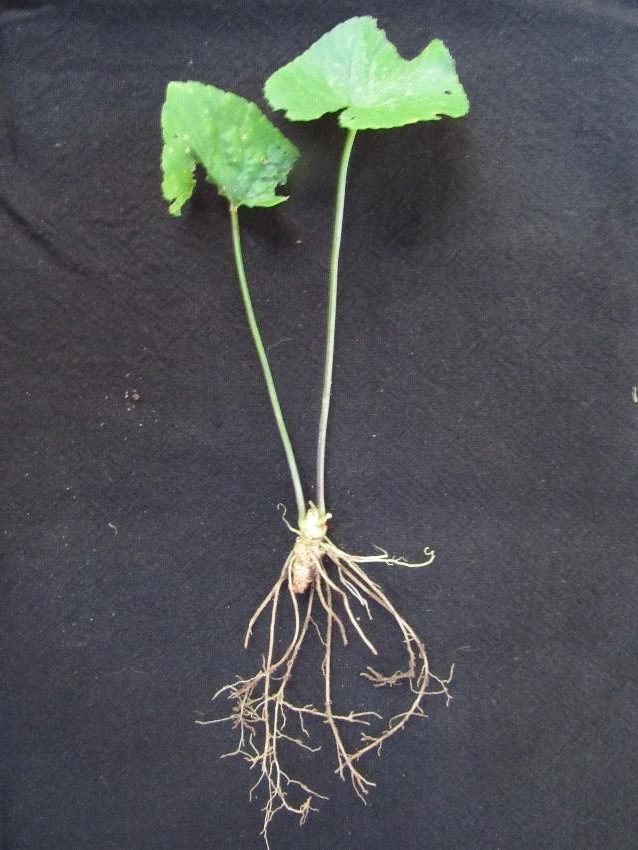


Harvesting
| Jan | Feb | Mar | Apr | May | Jun | Jul | Aug | Sep | Oct | Nov | Dec | ||||||||||||||
|---|---|---|---|---|---|---|---|---|---|---|---|---|---|---|---|---|---|---|---|---|---|---|---|---|---|
| winter | winter | late winter | early spring | spring | late spring | early summer | summer | late summer | early fall | fall | late fall | ||||||||||||||
| greens | x | x | x | x | x | x | x | x | x | x | x | x | |||||||||||||
Is this a good enrichment item? Not really.
Harvesting Greens: You can harvest violet leaves anytime. Like most greens, they are of the best texture when young and soft, but can be harvested until mid-fall. Cut a few leaves at a time at the base. If you have a large bed of violets you want to thin, you can pull up whole plants after a soaking rain. Plants with roots still attached will stay fresh longer in the refrigerator, but I’d chop off the roots before serving to animals because there are some species whose roots contain alkaloids that could act as an emetic, causing vomiting (Elpel, 2013). Flowers, however, can be harvested and fed along with the greens.
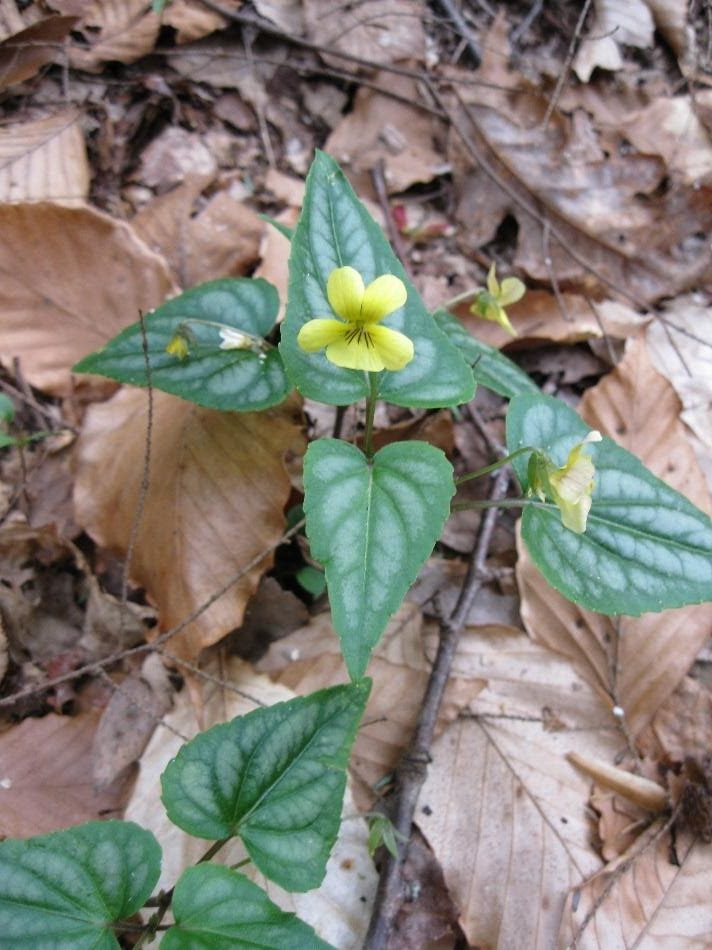
How to Store Prepared Greens: If you choose to, use a commercial vegetable cleaner or a ¼ cup of vinegar added to water as a cleaner. Submerge the plant material and swish it around to remove all dirt from leaves and roots. Rinse in clean water. Place in a colander or salad spinner to drain, then lay out a towel and spread the greens on the towel and roll up the towel. Unroll and transfer the damp greens to a 1-gallon zip-lock baggie with 12-15 holes cut in it to provide air and keep the greens from molding (or use a commercial vegetable bag designed to extend the life of greens in the refrigerator or reuse bags that package grapes). Label the bag with the plant name and which animals it should be used for. Do not use if greens become moldy, slimy or dried out and keep in the vegetable drawer of the refrigerator. Greens are good until they become dry and crispy, fade in color, or become slimy or moldy—about 1 week.
Other Species: It is difficult to sort out violets when there are so many hybrids, especially when you try to avoid threatened species. Do the best you can. Harvesting the leaf using the ethical harvesting guidelines (no more than 1/3 of the plant (leave the root) and harvest only off of 1/3 of the plants available) will help cover if you accidentally do harvest a threatened species. But do check your county, and try to become familiar with the endangered species of your area. Best yet…buy some violets from your nursery and grow your own to harvest! Violets transplant well and spread within a couple of years, but not invasively so.
Rare Species in Virginia
Do you live in one of these Virginia counties? If so, be aware that there are some species near you that may be threatened or endangered. Do more research to make sure you are identifying your target species correctly and not harvesting a threatened species!
| County in Virginia | Species | Alert |
| Albemarle | smooth white violet | Globally secure—common, widespread and abundant. But vulnerable— moderate risk of extirpation in Virginia. |
| Allegheny | prairie violet | Globally secure—common, widespread and abundant. However, in Virginia, Critically imperiled— at very high risk of extirpation. |
| Augusta | large-leaved white violet | Globally appears secure— uncommon, but not rare. Concern for the long-run. In Virginia, item is not ranked. |
| Augusta | smooth white violet | Globally secure—common, widespread and abundant. But vulnerable— moderate risk of extirpation in Virginia. |
| Bath | prairie violet | Globally secure—common, widespread and abundant. However, in Virginia, Critically imperiled— at very high risk of extirpation. |
| Bedford | large-leaved white violet | Globally appears secure— uncommon, but not rare. Concern for the long-run globally. |
| Bedford | smooth white violet | Globally secure—common, widespread and abundant. But vulnerable— moderate risk of extirpation in Virginia. |
| Bland | smooth white violet | Globally secure—common, widespread and abundant. But vulnerable— moderate risk of extirpation in Virginia. |
| Bland | prostrate blue violet | Globally appears secure— uncommon, but not rare. Concern for the long-run globally. In Virginia, imperiled with a high risk of extirpation. |
| Botetourt | smooth white violet | Globally secure—common, widespread and abundant. But vulnerable— moderate risk of extirpation in Virginia. |
| Botetourt | prostrate blue violet | Globally appears secure— uncommon, but not rare. Concern for the long-run globally. In Virginia, imperiled with a high risk of extirpation. |
| Carroll | three-parted violet | Globally secure—common, widespread and abundant. However, in Virginia, Critically imperiled— at very high risk of extirpation. |
| Charles City | salad violet | Globally secure—common, widespread and abundant. But vulnerable— moderate risk of extirpation in Virginia. |
| Chesapeake | coast violet | Globally secure—common, widespread and abundant. But vulnerable— moderate risk of extirpation in Virginia. |
| Chesapeake | salad violet | Globally secure—common, widespread and abundant. But vulnerable— moderate risk of extirpation in Virginia. |
| Fairfax | smooth white violet | Globally secure—common, widespread and abundant. But vulnerable— moderate risk of extirpation in Virginia. |
| Fauquier | large-leaved white violet | Globally appears secure— uncommon, but not rare. Concern for the long-run. In Virginia, item is not ranked. |
| Floyd | smooth white violet | Globally secure—common, widespread and abundant. But vulnerable— moderate risk of extirpation in Virginia. |
| Floyd | three-parted violet | Globally secure—common, widespread and abundant. However, in Virginia, Critically imperiled— at very high risk of extirpation. |
| Giles | smooth white violet | Globally secure—common, widespread and abundant. But vulnerable— moderate risk of extirpation in Virginia. |
| Giles | smooth white violet | Globally secure—common, widespread and abundant. But vulnerable— moderate risk of extirpation in Virginia. |
| Gloucester | coast violet | Globally secure—common, widespread and abundant. But vulnerable— moderate risk of extirpation in Virginia. |
| Grayson | smooth white violet | Globally secure—common, widespread and abundant. But vulnerable— moderate risk of extirpation in Virginia. |
| Grayson | prostrate blue violet | Globally appears secure— uncommon, but not rare. Concern for the long-run globally. In Virginia, imperiled with a high risk of extirpation. |
| Greene | smooth white violet | Globally secure—common, widespread and abundant. But vulnerable— moderate risk of extirpation in Virginia. |
| Greensville | coast violet | Globally secure—common, widespread and abundant. But vulnerable— moderate risk of extirpation in Virginia. |
| Greensville | salad violet | Globally secure—common, widespread and abundant. But vulnerable— moderate risk of extirpation in Virginia. |
| Hampton | coast violet | Globally secure—common, widespread and abundant. But vulnerable— moderate risk of extirpation in Virginia. |
| Henry | smooth white violet | Globally secure—common, widespread and abundant. But vulnerable— moderate risk of extirpation in Virginia. |
| Highland | smooth white violet | Globally secure—common, widespread and abundant. But vulnerable— moderate risk of extirpation in Virginia. |
| Isle of Wight | salad violet | Globally secure—common, widespread and abundant. But vulnerable— moderate risk of extirpation in Virginia. |
| James City | coast violet | Globally secure—common, widespread and abundant. But vulnerable— moderate risk of extirpation in Virginia. |
| Madison | smooth white violet | Globally secure—common, widespread and abundant. But vulnerable— moderate risk of extirpation in Virginia. |
| Middlesex | salad violet | Globally secure—common, widespread and abundant. But vulnerable— moderate risk of extirpation in Virginia. |
| Montgomery | prostrate blue violet | Globally appears secure— uncommon, but not rare. Concern for the long-run globally. In Virginia, imperiled with a high risk of extirpation. |
| Montgomery | three-parted violet | Globally secure—common, widespread and abundant. However, in Virginia, Critically imperiled— at very high risk of extirpation. |
| Montgomery | northern blue violet | Globally secure—common, widespread and abundant. But vulnerable— moderate risk of extirpation in Virginia. |
| Nelson | smooth white violet | Globally secure—common, widespread and abundant. But vulnerable— moderate risk of extirpation in Virginia. |
| Northampton | coast violet | Globally appears secure— uncommon, but not rare. Concern for the long-run. In Virginia, vulnerable with moderate risk of extirpation. |
| Pittsylvania | smooth white violet | Globally secure—common, widespread and abundant. But vulnerable— moderate risk of extirpation in Virginia. |
| Pittsylvania | northern blue violet | Globally secure—common, widespread and abundant. But vulnerable— moderate risk of extirpation in Virginia. |
| Prince George | coast violet | Globally secure—common, widespread and abundant. But vulnerable— moderate risk of extirpation in Virginia. |
| Pulaski | prostrate blue violet | Globally appears secure— uncommon, but not rare. Concern for the long-run globally. In Virginia, imperiled with a high risk of extirpation. |
| Pulaski | northern blue violet | Globally secure—common, widespread and abundant. But vulnerable— moderate risk of extirpation in Virginia. |
| Roanoke | northern blue violet | Globally secure—common, widespread and abundant. But vulnerable— moderate risk of extirpation in Virginia. |
| Rockbridge | large-leaved white violet | Globally appears secure— uncommon, but not rare. Concern for the long-run. In Virginia, item is not ranked. |
| Rockbridge | smooth white violet | Globally secure—common, widespread and abundant. But vulnerable— moderate risk of extirpation in Virginia. |
| Rockingham | large-leaved white violet | Globally appears secure— uncommon, but not rare. Concern for the long-run. In Virginia, item is not ranked. |
| Rockingham | smooth white violet | Globally secure—common, widespread and abundant. But vulnerable— moderate risk of extirpation in Virginia. |
| Russell | prostrate blue violet | Globally appears secure— uncommon, but not rare. Concern for the long-run globally. In Virginia, imperiled with a high risk of extirpation. |
| Shenandoah | smooth white violet | Globally secure—common, widespread and abundant. But vulnerable— moderate risk of extirpation in Virginia. |
| Smyth | smooth white violet | Globally secure—common, widespread and abundant. But vulnerable— moderate risk of extirpation in Virginia. |
| Southampton | coast violet | Globally secure—common, widespread and abundant. But vulnerable— moderate risk of extirpation in Virginia. |
| Suffolk | salad violet | Globally secure—common, widespread and abundant. But vulnerable— moderate risk of extirpation in Virginia. |
| Surry | coast violet | Globally secure—common, widespread and abundant. But vulnerable— moderate risk of extirpation in Virginia. |
| Sussex | coast violet | Globally secure—common, widespread and abundant. But vulnerable— moderate risk of extirpation in Virginia. |
| Sussex | salad violet | Globally secure—common, widespread and abundant. But vulnerable— moderate risk of extirpation in Virginia. |
| Virginia Beach | coast violet | Globally secure—common, widespread and abundant. But vulnerable— moderate risk of extirpation in Virginia. |
| Washington | smooth white violet | Globally secure—common, widespread and abundant. But vulnerable— moderate risk of extirpation in Virginia. |
| Wise | smooth white violet | Globally secure—common, widespread and abundant. But vulnerable— moderate risk of extirpation in Virginia. |
| Wythe | smooth white violet | Globally secure—common, widespread and abundant. But vulnerable— moderate risk of extirpation in Virginia. |
| Wythe | prostrate blue violet | Globally appears secure— uncommon, but not rare. Concern for the long-run globally. In Virginia, imperiled with a high risk of extirpation. |
Feed Violet Greens to:
violet | (Viola spp.) | greens |
|---|---|---|
Cottontail, Eastern | Sylvilagus floridanus |
|
violet | (Viola spp.) | roots/tubers/corms |
Mouse, Common White-footed | Peromyscus leucopus |
|
violet | (Viola spp.) | seeds |
Mouse, Common White-footed | Peromyscus leucopus |
|
Vole, Pine | Microtus pinetorum |
|
Voles, various spp. | various species |
|
Dove, Ground | Columbina passerina |
|
Dove, Mourning | Zenaida macroura |
|
Grosbeak, Evening | Coccothraustes vespertinus |
|
Junco, Dark-eyed | Junco hyemalis |
|
Pipit, American | Anthus rubescens |
|
Sparrow, White-throated | Zonotrichia albicollis |
|
Bobwhite, Northern | Colinus virginianus |
|
Grouse, Ruffed | Bonasa umbellus |
|
Turkey, Wild | Meleagris gallopavo |
|
Book References
Elpel, T.J. (2013) Botany in a Day (APG). Pony, Montana: Hops Press, LLC.
Martin, A.C., Zim, H.S., Nelson, A.L. (1951). American Wildlife and Plants: A Guide to Wildlife Food Habits. New York: Dover Publications.
Scott, M. (2013). Songbird Diet Index. National Wildlife Rehabilitators Association, St. Cloud, MN.
Townsend, J. F. (2015, April) Rare Plants Natural Heritage Technical Report 15-10. (Unpublished Report) Richmond, Virginia: Virginia Department of Conservation and Recreation, Division of Natural Heritage.
Online References
Virginia Botanical Associates. (Accessed November 2015). Digital Atlas of the Virginia Flora (http://www.vaplantatlas.org). c/o Virginia Botanical Associates, Blacksburg.
USDA, NRCS. 2015. The PLANTS Database (http://plants.usda.gov, 24 November 2015). National Plant Data Team, Greensboro, NC 27401-4901 USA.

